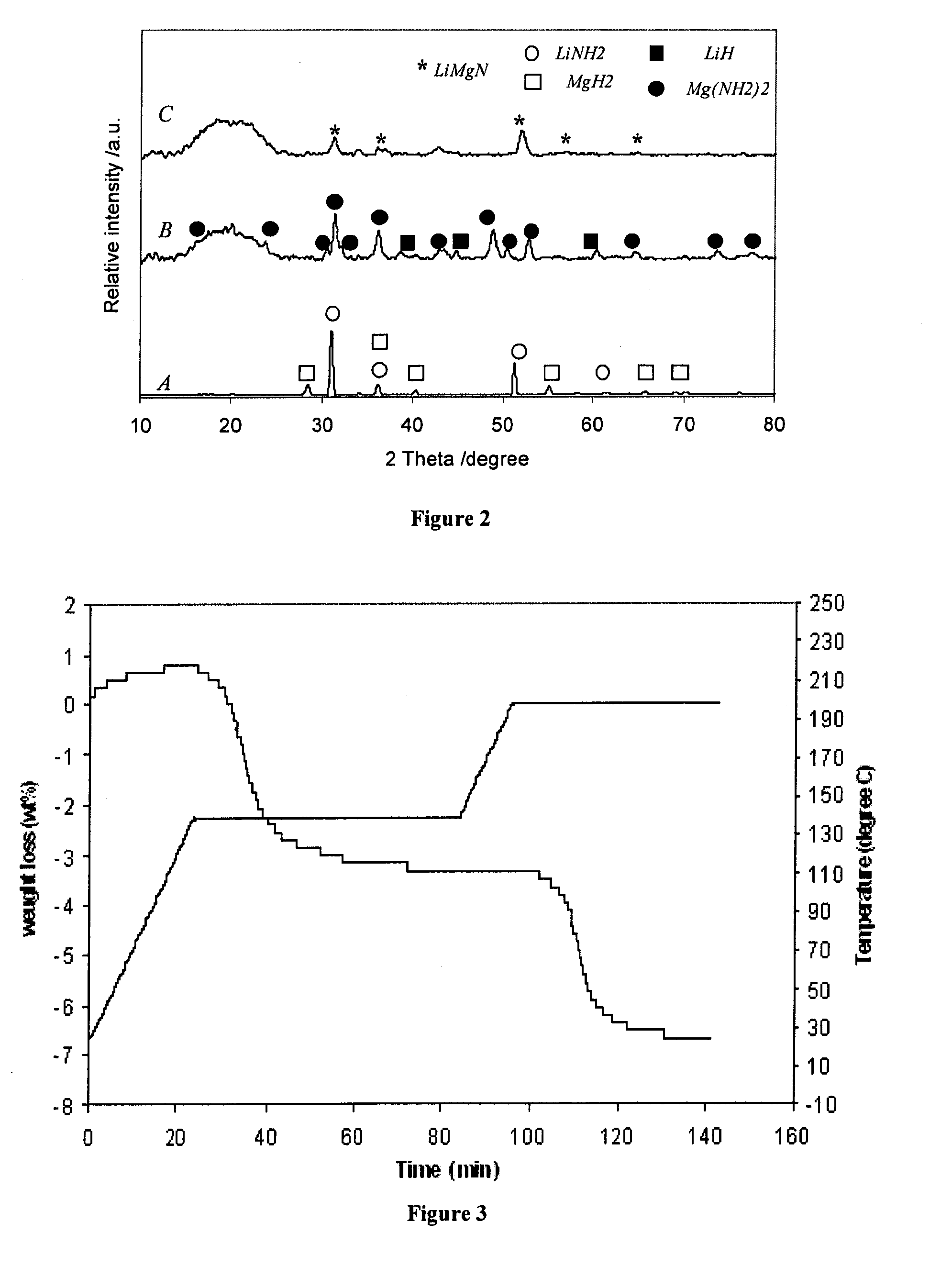Light metal based material system for hydrogen storage
a technology of hydrogen storage and metal based materials, applied in the fields of metallurgy, materials science, chemical instruments and processes, nitrogen compounds, etc., can solve the problems of compressed hydrogen not giving a car as useful a travel range as gasoline, and the density of hydrogen is also much less
- Summary
- Abstract
- Description
- Claims
- Application Information
AI Technical Summary
Benefits of technology
Problems solved by technology
Method used
Image
Examples
example 1
Preparation of LiMgN
[0060]The starting materials, lithium amide (LiNH2, 95%), magnesium hydride (MgH2), were purchased from Aldrich Chemical and used as received without any further purification. To prevent samples and raw materials from undergoing oxidation and / or hydroxide formation, they were stored and handled in an argon-filled glove box. Reactant mixtures were prepared using mechanical milling. Approximately 2.0 g mixtures were milled with a Spex 8000 mill or jar-roll mill under argon atmosphere with the ball to powder ratio of 35:1 by weight. The milling time was varied from 12 to 24 hours.
[0061]The thermal gas desorption properties of the mixture (MgH2 / LiNH2) were determined by thermogravimetry analyzer (TGA, Shimadzu TGA50) and differential thermal analyzer (DTA Shimadzu DTA50) upon heating to 220-250° C. at a heating rate of 5° C. / min. This equipment was especially designed and built for using it inside the argon-filled glove box equipped with a regeneration system, which ...
example 2
Preparation of Lithium-Magnesium Hydride / Amide / Imide Compounds
[0067]The hydrogen absorption properties of the LiMgN from Example 1 were performed by using a custom-made autoclave, whose hydrogen pressure limit is up to 5000 psi, and temperature is programmed up to 500° C. Specifically, rehydrogenation was conducted by heating 500 mg of the LiMgN to 240-300° C. at a heating rate of 5° C. / min under argon atmosphere, and then holding at 240-300° C. for 1-7 hour under 2000 psi of pressurized hydrogen.
[0068]The hydrogenation of LiMgN and the reversibility of reaction described by Formula 1 was investigated by placing the LiMgN in a custom-made autoclave and pressurized in H2. The hydrogenation experiment was carried out at 2000 psi and 240° C.
[0069]The hydrogenated product was analyzed using TGA. FIG. 3 shows TGA profile of the hydrogenated sample. FIG. 3 shows that the sample adsorbed about 7.2 wt % of hydrogen during the experiment. However, from the TGA results, the dehydrogenation be...
example 3
Preparation of Hydrogenated Lithium Magnesium Products
[0073]Another mixture MgH2 / LiNH2 was prepared using a high-energy ball milling method—planetary milling. After high energy milling, the sample was again subjected to analysis using TGA. FIG. 1B shows TGA profile of this mixture after high-energy-high-pressure (HEHP) planetary milling under 70 bar of hydrogen for 2 hours. The weight loss of this sample was approximately 7 wt %, which is significantly lower than that of the sample after jar-roll milling. Moreover, from the TGA profile shown in FIG. 1B, the dehydrogenation process appears to be a two-step process rather than the one-step process from the sample after jar-roll milling. The first step occurred between the temperature range of 140-200° C., and the second step between the temperature range of 200-240° C. This dehydrogenation behavior is similar to the hydrogenated LiMgN.
[0074]DTA and XRD analyses were carried out to further verify these specific reaction steps during HE...
PUM
 Login to View More
Login to View More Abstract
Description
Claims
Application Information
 Login to View More
Login to View More - R&D
- Intellectual Property
- Life Sciences
- Materials
- Tech Scout
- Unparalleled Data Quality
- Higher Quality Content
- 60% Fewer Hallucinations
Browse by: Latest US Patents, China's latest patents, Technical Efficacy Thesaurus, Application Domain, Technology Topic, Popular Technical Reports.
© 2025 PatSnap. All rights reserved.Legal|Privacy policy|Modern Slavery Act Transparency Statement|Sitemap|About US| Contact US: help@patsnap.com



